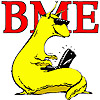
|
| SoE home |

|
| Kevin Karplus's home page |

|
| Biomolecular Engineering Department |
(Last Update: 2015 May 28 18:22 PDT )
The course is intended for sophomores and juniors in bioengineering with priority given to bioengineering majors, but is open to anyone who meets the prerequisites:
Students considering the bioelectronics concentration should take BME 101/L early (before EE 101/L), which may be difficult to schedule because of the prereqs. Students who did well in high-school physics may request a waiver of the physics prereq, which may be granted if there is room in the course and the student is sufficiently convincing about their ability to handle the material.
The theme for the course is "connecting real-world signals to computers using analog electronics", and we will be working with interfacing thermistors, microphones, electrodes, photo-detectors, capacitance sensors, and strain-gauge pressure sensors to microprocessors (Arduinos or Freescale's KL25Z). The final lab will be the design, implementation, and testing of a small single-channel electrocardiogram (or electromyogram).
The old bioengineering curriculum (before the 2014–15 catalog) will accept this course as fulfilling the EE101/L (circuits) requirement, but EE will not be accepting it as a prerequisite for further electronics courses. It is possible to take both the Applied Circuits course and EE 101/L for credit, though there is some overlap in content. The new (starting 2014–15) curriculum for bioengineers requires BME 101/L for all concentrations, and EE 101/L in addition for the bioelectronics and assistive technology: motor concentration.
Currently, the best description of the course is on Prof. Karplus's
blog:
http://gasstationwithoutpumps.wordpress.com/circuits-course-table-of-contents/
but most students probably don't want to read the hundreds of pages of
notes there on the design of the course.
Students will learn to use standard electronics equipment (multimeters, oscilloscopes, function generators, power supplies) and tools (pliers, wire strippers, breadboards, soldering irons). The course is an engineering design course—I tried to make the labs require design, not just cookbook procedures. The complexity of the design tasks should ramp up through the quarter.
Although BME 101 is no longer a prototype but a regular course, I will seek frequent feedback from the students in the course about improvements that can be made. There are substantial changes from the previous two runs of the course, including a rescheduling of the labs and a new text.
This year the parts and tools are covered by the course lab fees. There are about $80 worth of tools, parts, microcontroller board, and USB cable—the charged lab fee is $130, because the fee also covers wire, solder, printing, fuses for the ammeters, broken oscilloscope probes, and cost overruns from having to use UC-approved vendors (who often don't have the cheapest prices). I think that the lab fee is bigger than it needs to be, but BELS thinks it is too small (we have different views on how much extra should be in the budget beyond the parts kit itself). These tools and parts need to be obtained by the first lab meeting, as we will be using them immediately. Dropping the course does not result in a refund of lab fees if you have already gotten the tools and parts.
Warning: the KL25Z boards are sold without headers (for people who want to solder them directly into projects), but you will need the headers to plug wires in temporarily. We will be soldering headers onto the KL25Z boards in the first week.
All the software you need to use is installed on the lab computers, but you may want to get your own copies for use on your laptop. All the software is free:
Data acquisition software was developed specifically for this
course, and is available
from http://bitbucket.org/abe_k/PteroDAQ/downloads
under the "Tags" tab. Select the "default" branch under the
"branches" tab and download in zip, gz, or bzip2 archive format.
A version is installed on the lab machines at C:\ProgramFiles\PteroDAQ.
Documentation is downloaded with the source.
To run the data logger, you will need Python2.7 or Python3.4 with PySerial for communicating with the board. (Note: I've had some problems with Python 2.7 and PteroDAQ on Mac OS X, but it works fine with Python 3.4. )
Either Python 2.7 or Python3.4 can be used with the Data Logger code, but you need to install the PySerial module—this is the only non-standard module needed (Tkinter, which is also used, is part of the standard Python library). Note: Mac OS X often comes with an ancient version of Python, so you are likely to need to update your Python. See the documentation at python.org
We'll be doing plotting and model-fitting examples with gnuplot. You can choose to use other tools if you are more familiar with them and have sufficient mastery of them to fit complex functions and produce good-looking graphs. Gnuplot can be downloaded from the http://www.gnuplot.info/ website, but installation on Macs is sometimes tricky. See the post and comments on Karplus's blog about installing gnuplot on a Mac. The comment by Chuy is probably the most useful.
To offset the high parts cost, we'll be using only free on-line material for the textbook.
The labs this year are contained in the textbook, rather than as separate lab handounts. It is essential to read the lab chapters and do the design work before coming to lab—this is a design class, not lab-demo class, so most of the writing and thinking has to happen before the lab time. Students in past years who did not have completed designs before lab generally wasted a lot of lab time doing pencil-and-paper work and had trouble getting their designs built and tested.
Lab reports will be due at the beginning of class every Friday, starting with Lab 2 on sampling and aliasing. Labs 5 and 6 are in the same week, and will have a combined report, so there are a total of ten reports. I will endeavor to have lab reports graded and returned with detailed feedback in the next class (Monday).
Each lab will be done with a different partner (and occasional singletons). There should be no repeat pairings (unless the lab section has fewer than 11 students). Pre-lab work should be done separately, but postlab work can be done together or separately.
Read each lab chapter (twice) the day before the lab—there will often be pre-lab design work to do due on Mondays, and there won't be time during lab to do the design work. Some weeks have two lab chapters—read both the weekend before the labs and do the pre-lab exercises, so that you can ask questions on Mondays.
| Date | Lab |
|---|---|
| Tues 31 Mar 2015 | Lab 1: setting up |
| Thurs 2 Apr 2015 | Lab 2: sampling and aliasing |
| Tues 7 Apr 2015 | Lab 3: temperature measurement |
| Thurs 9 Apr 2015 | Lab 3: temperature measurement |
| Tues 14 Apr 2015 | Lab 4: electret microphones |
| Thurs 16 Apr 2015 | Lab 4: electret microphones |
| Tues 21 Apr 2015 | Lab 5: loudspeaker modeling |
| Thurs 23 Apr 2015 | Lab 6: hysteresis, touch sensor |
| Tues 28 Apr 2015 | Lab 7: electrodes |
| Thurs 30 Apr 2015 | Lab 7: electrodes |
| Tues 5 May 2015 | Lab 8: low-power audio amplifier |
| Thurs 7 May 2015 | Lab 8: low-power audio amplifier |
| Tues 12 May 2015 | Lab 9: pressure sensor (blood pressure) |
| Thurs 14 May 2015 | Lab 9: pressure sensor (blood pressure) |
| Tues 19 May 2015 | Lab 10: optical pulse monitor |
| Thurs 21 May 2015 | Lab 10: optical pulse monitor |
| Tues 26 May 2015 | Lab 11: class-D power amp |
| Thurs 28 May 2015 | Lab 11: class-D power amp |
| Tues 2 Jun 2015 | Lab 12: EKG |
| Thurs 4 Jun 2015 | Lab 12: EKG |
Anyone caught cheating in the class will be reported to their college provost (see UCSC policy on academic integrity) and may fail the class. Cheating includes any attempt to claim someone else's work as your own. Plagiarism in any form (including close paraphrasing) will be considered cheating. Use of any source without proper citation will be considered cheating. If you are not certain about citation standards, please ask, as I hate having to fail students because they were improperly taught how to cite sources.
Collaboration without explicit written acknowledgment will be considered cheating. Collaboration on lab assignments is expected, even required—but that doesn't remove the requirement to acknowledge the collaboration.
| Due | Read | Turn in |
|---|---|---|
| Tues Mar 31 | Chapter 0, Lab 1, Chapter 2 | |
| Wed Apr 1 | Chapter 3, Lab 2 | |
| Fri Apr 3 | Chapter 5 | Lab report for Labs 1 and 2 (beginning of class) on paper |
| Mon Apr 6 | Lab 3 | Exercises and pre-lab design work from Chapter 5 and Lab 3 |
| Fri Apr 10 | Sections 7.1, 7.3 (through 7.3.2 in Apr 7 draft) | Lab 3 report |
| Mon Apr 13 | Chapters 8-10, Lab 4 | Prelab exercises for Lab 4 |
| Fri Apr 17 | Sections 7.2, 7.3.3, Chapter 12, Lab 5 | Lab 4 report |
| Mon Apr 20 | Chapter 14 | Prelab exercises for Lab 5 |
| Wed Apr 22 | Lab 6 (should be earlier) | Prelab exercies for Lab 6 (should be earlier) |
| Fri Apr 24 | Chapter 16, Lab 7 | Labs 5 and 6 report. |
| Mon Apr 27 | Prelab exercises for Lab 7 | |
| Wed Apr 29 | Chapter 18 | |
| Fri May 1 | Lab 8 | Lab 7 report. |
| Mon May 4 | Pre-lab exercises for Lab 8 | |
| Wed May 6 | Chapters 20 and 21 | |
| Fri May 8 | Lab 9 | Lab 8 report. |
| Mon May 11 | Pre-lab exercises for Lab 9 | |
| Wed May 13 | Chapter 23 | Lab 9 report. |
| Fri May 15 | Lab 10 | Lab 9 report. |
| Mon May 18 | Chapter 25 | Pre-lab exercises for Lab 10 |
| Fri May 22 | Lab 11 | Lab 10 report. |
| Mon May 25 | Memorial Day, no class | |
| Wed May 27 | Chapter 27 | |
| Fri May 30 | Lab 12 | Lab 11 report. |
| Mon Jun 1 | Pre-lab for Lab 12 | |
| Fri Jun 5 | Lab 12 report. | |
| Mon Jun 8 | Last call for redone or late lab reports. 4pm |
|
|
| BME101 home page |
Questions about page content should be directed to
Kevin Karplus
Biomolecular Engineering
University of California, Santa Cruz
Santa Cruz, CA 95064
USA
karplus@soe.ucsc.edu
1-831-459-4250
318 Physical Sciences Building